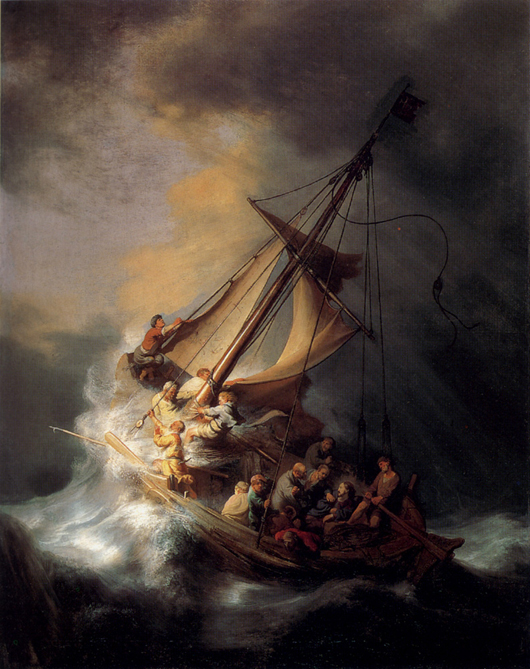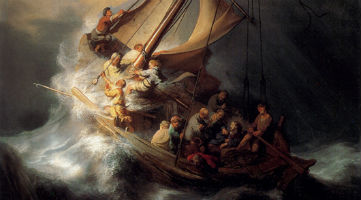
AMESBURY, Mass. (AP) – The Amesbury Rotary Club got a firsthand account of possibly the most notorious unsolved art heist in 20th century history when retired FBI agent and supervisor Tom Cassano addressed the group last week.
“This was the biggest art heist in the country,” Cassano said. “Possibly in all of North and South America.”
A Brooklyn, N.Y., native, Cassano recalled his early days beginning as an agent in 1969 up until the date that is now etched in Boston’s history.
“On March 18, 1990, the Isabella Stewart Gardner Museum was robbed,” Cassano said. “Two individuals dressed as Boston police officers knocked on the side door of the museum, and at the time, there were two security personnel. They were part-time students who had nothing else to do at night, so they took a job at the museum.
“There were millions and millions of dollars’ worth of paintings and these two guys were the only ones who were charged with preventing what (was about) to happen. They admitted what they thought were the two Boston police officers and were told there was a problem in the courtyard that they had to investigate.”
The two men were not police officers at all and they tied up the two security guards, Cassano said. They then proceeded to make off with works by Degas, Flinck and Manet, along with Rembrandt’s only known seascape, The Storm on the Sea of Galilee, and The Concert by Vermeer.
“Depending on who you ask, the value of the stuff taken was anywhere from $200 million to $500 million,” Cassano said. “As of the time I left (in 2001), they knew no more than they did the day it happened. We are not sure how many (suspects) there were. We know there were at least two. These two guards were put down in the basement so nobody kept track of what was happening. We know how they came in, but we don’t know how they got out.”
In the days immediately following the heist, Cassano’s office had over 15 agents working full-time gathering evidence, locating, interviewing and eliminating every possible suspect that sprang to mind, only to come up empty. The FBI would also offer up to a $5 million reward for information that would lead to a conviction in the case.
“Every prisoner who was incarcerated at the time knew that this was a ‘get out of jail free’ card if they could come up with these bandits,” Cassano said. “I don’t know how many calls we got. We had hundreds and hundreds of leads and none of them panned out to this day, as far as I know.”
According to Cassano, notorious art thief Myles Connor was one of the most obvious suspects. There was only one problem.
“In the beginning we thought it was Myles Connor, even though he was in jail,” Cassano said. “He worked the Back Bay, he knew the area, so we thought that maybe he commissioned it. He has been out of jail for quite sometime now. I know that more than a couple of years ago, he suffered a serious heart attack that I believe affected his brain, so if he did it, we couldn’t know.”
The paintings were also not insured, so an insurance job was out of the question.
“They didn’t have the money for insurance,” Cassano said. “Mrs. Gardner had it in her will that nothing will be taken from this museum and sold, and that is the way that museums make money. They couldn’t do that at the Gardner, so all of the stuff went uninsured.”
Five years would go by before Cassano and his fellow agents would run across a good lead.
“We ran into a guy by the name of Billy Youngworth,” Cassano said. “He was an antiques dealer in Randolph, I believe. He had hooked up with a Boston Herald reporter and he convinced this reporter that he knew or he could broker the return of all these paintings.”
None of Youngworth’s information panned out, according to Cassano.
“We tried every angle you could think of,” Cassano said. “Drugs (and) the IRA (Irish Republican Army) was very active at the time.”
It was a possible IRA connection that Cassano said may have provided the best lead, as far as he was concerned, but that trail would also end up going cold.
“There was an IRA guy,” Cassano said. “We know who he was and it was shortly thereafter that he was shot and killed by his wife, who died from a heroin overdose. If that is the case and he was the suspect and he stashed the (paintings) somewhere, who knows where they are.”
Cassano also took questions from the Rotary Club and their guests, telling them the FBI has become a very different organization since he retired in 2001.
“When I worked it, it was mostly criminal work with a little counter-intelligence,” Cassano said. “Today it is all terrorism and a little bit of criminal work. This is still a major criminal case in the Boston office, it will be until they recover this stuff. But it is going the other way. The crime of the times now is terrorism.”
___
By JIM SULLIVAN, The Daily News of Newburyport
Information from: The Daily News of Newburyport (Mass.), http://www.newburyportnews.com
Copyright 2016 Associated Press. All rights reserved. This material may not be published, broadcast, rewritten, or redistributed.
AP-WF-05-09-16 1357GMT


